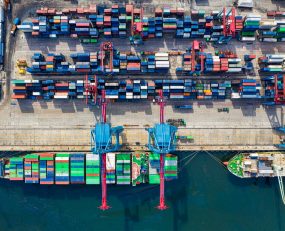
According to the IMF, global trade levels are now projected to reach pre-COVID levels in 2021. This outcome looked less likely earlier in the year as the pandemic began to decimate the global economy.
Consumer demand has remained strong throughout the pandemic. Unlike the last previous global recession in 2009, where consumer confidence and demand plummeted, the shock was very different this time around. Expenditure in services has been hit badly, but lockdowns brought about a healthy demand for some consumer goods. Demand for laptops, personal gym equipment and DIY goods, for example, have increased due to restrictions on everyday life, with e-commerce providing a crucial sales outlet. State support schemes have limited unemployment rises, keeping consumer spending reasonably solid.
In some areas, such as on Trans-Pacific lanes, trade growth has comfortably surpassed pre-COVID levels. This gives credence to the view that global trade and freight forwarding will recover to pre-pandemic levels in the near future.
GDP and trade growth dynamics are important to understanding growth in the freight forwarding market. From 2010-2019, trade grew 1.1 times faster than GDP. In previous decades, this multiplier had been higher, but the globalisation trend has since slowed. Over 2021-2024, the IMF expects this multiplier to be 1.2, buoyed by a strong recovery in trade in 2021.
The trade war and pandemic have increased speculation around the reversal of globalisation, which would in turn decrease the multiplier. In a Ti-Bollore survey released in September, 34% of respondents agreed that COVID-19 would lead to the end of globalisation and the re-emergence of national/local supply chains. However, this re-orientation of supply chains would require vast effort and bring about substantial costs. Supply chain diversification appears much more likely, which will benefit different trade lanes and could lead to interesting dynamics in Asia, where some countries will attempt to provide greater competition for China. Near-shoring is a threat to some air and sea freight forwarders’ volumes, given that intra-continental trade opens up more opportunities for land-based transport options. However, the economics of this are also sometimes challenging. Whilst some level of supply chain re-structuring appears likely post-COVID, trading conditions are expected to remain largely conducive to air and sea freight forwarding growth over the medium term.
Tight capacity has been a characteristic of both the air and sea freight forwarding markets in 2020. This is a trend which could continue in the years ahead, potentially weakening growth in each market. In sea freight, carriers have learned tough lessons from the past decade. After high expenditure on Post-Panamax ships, they have since consolidated and formed successful alliances, enabling them to cut capacity during the pandemic and keep rates at high levels. This trend, although likely not to the same extent, could continue in the years ahead, pushing some shippers to consider other modal options, such as rail or sea-air.
Meanwhile, capacity has been reduced involuntarily in the air freight market. The lack of air travel has severely reduced belly hold capacity. According to IATA, in the year to September, available cargo-tonne kilometres were 25.2% lower year-on-year. This lack of capacity has pushed shippers towards other modal options and could yet constrain the ability for air freight volumes to bounce back. Twice over the past decade, the air freight market has been boosted by inventory re-stocking cycles. These are characterised by a rapid acceleration in new export order growth, coming about at times when the global economy and trade are growing quickly. This last happened in 2017, whilst the previous occasion was after the global financial crisis. At these points in time, shippers seek to re-stock inventories to meet this sharp rush in demand and air freight is often the best way to achieve this.
However, given the constraints in capacity, air freight is unlikely to see such a sharp boost next year. After the global economy slumped to its lowest ebbs in April and May this year, some re-stocking did take place, but it was sea freight and the integrators (through their own international air networks), which saw an uptick in volumes most sharply. Air freight did not accelerate substantially alongside the uptick in new export orders as it had done on previous occasions. Ultimately, if we see further increases in demand going into 2021, air freight may not be able to fulfil all of it in the same way it has done in previous re-stocking cycles. Much depends on whether passengers feel safe flying again in 2021.
Both modes of freight forwarding should see a strong boost from the recovering industrial and automotive sectors next year, as well as continued positive growth in the healthcare and pharmaceutical sector. With the roll-out of a number of vaccines looking likely, volumes moved by air are likely to increase. Meanwhile, cross-border e-commerce volumes have accelerated this year and will provide a strong avenue for growth in years ahead. With these sectors performing well, forwarding volumes look set to recover over the medium term, despite the sector facing a number of headwinds.
Source: Transport Intelligence, November 24, 2020
Author: Andy Ralls
5-Year Forecasts for the Global Freight Forwarding Market will be published in December. For more information, please contact Michael Clover, Ti’s Head of Commercial Development, at [email protected]